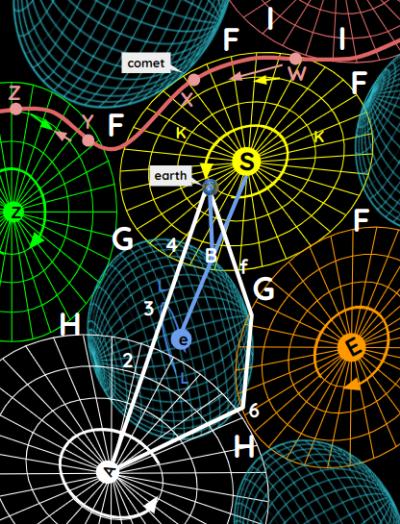The Origin of the Planets and Comets
Table of Contents
Superphysics Note
The aether that could not become the fire-aether or air-aether necessarily are the larger and more massive ones. These move out to the edges of the stellar gravitational territories onto other stellar gravitational territories without staying long in each territory.
By contrast, all the less massive aether had to be pushed, each toward the center of the air-aether containing it.
Upon colliding with each other, they join together and become large balls which rotate in their stellar gravitational territory.
Some of them move towards:
- the edges of their gravitational territory
- These are the comets
- the centers of their gravitational territory
- These are the planets
There are a few comets compared to the number of stellar gravitational territories.
- There were many at the beginning.
- But over time, they would have passed across different stellar gravitational territories.
- Almost all of them would have collided with one another and broken up, just as I have said 2 boats do when they meet, so that now only the largest remain.
When comets pass from one stellar gravitational territory into another, they always push before them some small bit of the air-aether that they are leaving.
They remain enveloped by it for some time until they have entered far enough within the limits of the other territory.
Once there, they finally loose themselves from it almost all at once.
In this way, they move much more slowly when they thus tend to leave some territory than they do shortly after having entered it.
For example, the comet that takes its course along the line WXYZ, has already entered far within the limits of the stellar gravitational territory FFFFGG.

Nevertheless, when it is at point W, it still remains enveloped by the air-aether from the territory FI where it came from. It cannot be entirely freed of that air-aether before it is around point X.
But, as soon as it has arrived at X, it begins to follow the course of territory FG and moves much faster than when it arrived.
It continues its course from X towards Z.
Its motion slows down little by little as it approaches point Y. This is both from:
- the resistance of the territory
FGHwhich it is entering - there being less distance between
sunandXthan betweensunandY- This makes all the air-aether between
sunandX(where the distance is smaller) move faster there - This is similar to how we see rivers always flow faster where their bed is narrower* and more confined than in those where it is wider and more extended.
- This makes all the air-aether between
Superphysics Note
This comet should be visible to those who live at the center of territory FFFFGG only during the time it takes to pass from X to Y.
Its motion should appear to viewers to be much faster, its body much greater, and its light much brighter, at the beginning of the time they see it than at the end.
The light from the comet spreads out and is distributed in all directions in the territory.